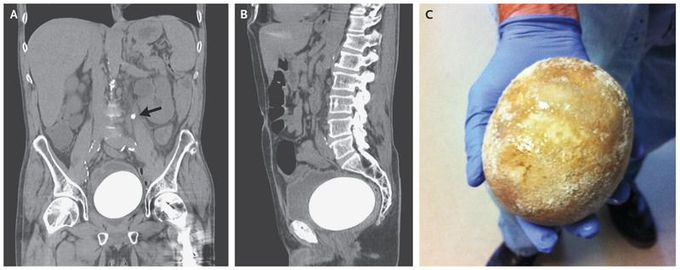


Neobladder Stone
A 64-year-old man presented to the emergency department with a 3-day history of pain in the left flank and urinary retention. He had undergone radical cystectomy and orthotopic neobladder construction with intestinal segments more than a decade earlier because of invasive bladder cancer. Physical examination revealed tenderness in the left flank. Computed tomography of the abdomen and pelvis showed an obstructing stone in the left proximal ureter (arrow) and a very large stone in the neobladder (Panels A and B). The use of intestinal segments to create urinary diversions can lead to stone disease as a result of persistent bicarbonate loss in the urine, hyperoxaluria, and long-term colonization of urea-splitting bacteria in the urinary tract. Additional risks for stone formation in a continent urinary reservoir, such as in our patient’s neobladder, include urinary stasis, mucus production, and nonabsorbable surgical materials used to construct the substitute bladder. The stone in the left ureter was accessed by means of percutaneous nephrostomy with antegrade ureteroscopic assistance and was removed with the use of laser lithotripsy. The patient underwent an open neocystolithotomy to extract the neobladder stone, which was egg shaped and measured 12 cm by 9.5 cm by 7.5 cm, weighed 770 g, and was composed of 20% struvite and 80% calcium phosphate (Panel C). The patient had no postoperative complications and continues to be monitored for stone recurrence.

